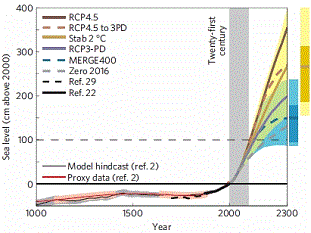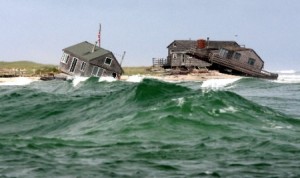New Studies on Sea Level Rise Make Clear We Must Act Now
 The bad news is that even modest global warming likely leads to dangerous sea level rise. The worse news is that continuing to do nothing about greenhouse gas emissions leads to levels of warming and sea rise that are unimaginably catastrophic.
The bad news is that even modest global warming likely leads to dangerous sea level rise. The worse news is that continuing to do nothing about greenhouse gas emissions leads to levels of warming and sea rise that are unimaginably catastrophic.Stabilizing at 2C (3.6F) warming leads to 2.5 feet of sea level rise by 2100 and a devastating 8 feet by 2300, a new analysis finds. The figure at the right is long-term sea level rise under scenarios of very aggressive CO2 mitigation (via one of the new studies, Schaeffer et al. in Nature Climate Change).
Stabilizing at 3C (the RCP4.5 scenario, close to 550 ppm CO2 levels) leads to about 3 feet of SLR by 2100 and over 11 feet of SLR by 2300. That would still require a huge amount of clean energy deployment in the coming decades (see here).
Staying near our current greenhouse emissions emissions path — the “reference” case below, which is not the worst-case scenario — still leads to over 40 inches of SLR by 2100 and then seas continue to rise 7 inches or more a decade!

How future generations would adapt to endlessly rising seas at that rate (or higher) is hard to imagine — even if it were not accompanied by many other simultaneous catastrophes, including Dust-Bowlification, ocean acidification, and ever-worsening extreme weather. The time to act is now.
The SLR analysis above is based on a “a semi-empirical approach” using historical data (see RealClimate). It does not factor in the possibility of nonlinear disintegration of the Greenland or West Antarctic ice sheets, which is already occurring.
Below the jump is a Climate Central excerpt on this study and two others that just came out, which suggest sea level rise could be even greater in key parts of coastal America
Three New Studies on Sea Level Rise Bring New Concerns
 Three new sea level rise studies published during the past week offer sobering lessons for coastal residents and policy makers, spelling trouble for portions of the East and West Coasts of the U.S.
Three new sea level rise studies published during the past week offer sobering lessons for coastal residents and policy makers, spelling trouble for portions of the East and West Coasts of the U.S.The first lesson is that sea levels won’t rise at the same rate everywhere — in fact, some unlucky places are already seeing sea levels rise at rates that are dramatically faster than the global average. Specifically, the 600-mile stretch of coastline from North Carolina to Massachusetts is experiencing rates that are nearly three to four times higher than the global average, a trend that may continue during the coming decades.
This finding comes from a study published June 24 in the journal Nature Climate Change. The study makes clear that some of the most valuable real estate in the country, from the beaches of North Carolina to the posh Hamptons in Long Island, and including major cities such as New York and Boston, may see severe coastal flooding events much earlier than other parts of the country.
As Margaret Davidson, director of the Coastal Services Center for the National Oceanic and Atmospheric Administration (NOAA) in Charleston, South Carolina, told the Associated Press that the new research has “huge” implications.
“Somewhere between Maryland and Massachusetts, you’ve got some bodaciously expensive property at risk,” she said.
The study, by researchers with the U.S. Geological Survey (USGS), emphasized that factors such as changing ocean currents, coastal land elevation fluctuations, and water temperature and salinity shifts in the North Atlantic Ocean are influencing the rate of sea level rise on the local level.
The study refers to the Cape Hatteras-to-Massachusetts stretch as a sea level rise “hotspot”….
“Ongoing accelerated sea level rise in the hotspot will make coastal cities and surrounding areas increasingly vulnerable to flooding by adding to the height that storm surge and breaking waves reach on the coast,” said Abby Sallenger, a USGS oceanographer and lead author of the study.
According to the Boston Globe, the study and others like it are prompting the city of Boston to require developers to take sea level rise into account when planning new development projects and take other climate change adaptation steps.
The USGS study is similar to a report on West Coast sea level rise that was published last week by the National Research Council. That report found that California stands to experience greater sea level rise impacts than other parts of the West Coast.
Climate Central’s research, entitled Surging Seas, shows that California, New York, and New Jersey have the third, fourth, and fifth largest populations on low-lying coastal land prone to sea level rise-driven coastal flooding issues, and New York City has the second largest population at risk of any city nationwide other than New Orleans.
Another paper from Nature Climate Change shows just how difficult it will be to avoid damaging amounts of sea level rise over the longer term unless greenhouse gas emissions are significantly slashed.
That study, by a research team in Germany, showed that even if global warming were limited to 2 degrees Celsius (3.6°F) compared to preindustrial times — a target that many policymakers and scientists now consider too difficult to achieve — global mean sea levels are likely to continue to rise during the next three centuries. On the bright side, the study found that emissions reductions that contain warming to 1.5°C (2.7°F) or below would “strongly” reduce sea level rise.
The researchers, led by Michiel Schaeffer of Climate Analytics and Wageningen University, found that if global average surface temperatures increase by more than 3°C, sea level rise could range between 6.6 and 16.4 feet by the year 2300, which would prove disastrous to many coastal population centers.
“… For New York City, it has been shown that 1 meter of sea level rise could raise the frequency of severe flooding from once per century to once every three years,” said study coauthor Stefan Rahmstorf of the Potsdam Institute for Climate Impact Research.
The study is the first long-term sea level rise projection that combines historical records of sea level rise during the past millennium with future scenarios for greenhouse gas emissions. It relied in part on estimates of the historical relationship between global average surface temperatures and global average sea level.
You can return to the main Market News page, or press the Back button on your browser.

